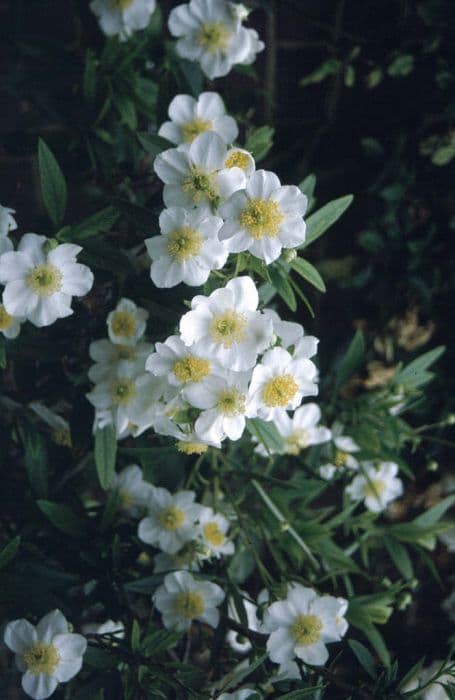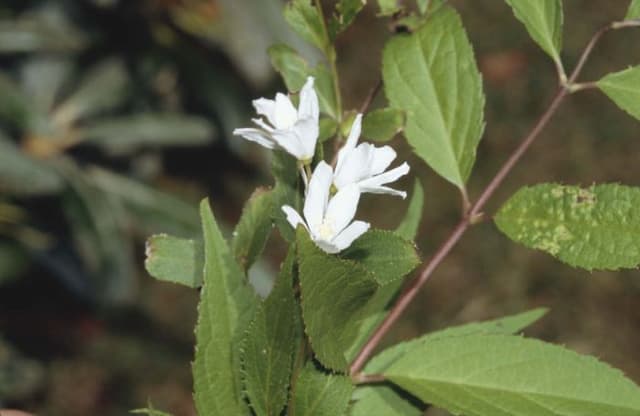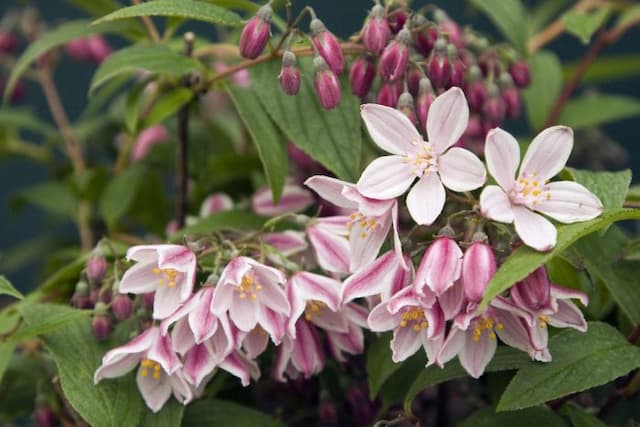Oakleaf Hydrangea Hydrangea quercifolia Snow Queen = 'Flemygea'
![oak-leaved hydrangea [Snow Queen]](/_next/image?url=https%3A%2F%2Fplants-admin.emdemapps.com%2Fimages%2Fplants%2F%2Fimages%2F604b53cf69e5e.png&w=3840&q=75)
ABOUT
The Snow Queen Oakleaf Hydrangea is a visually striking plant known for its noteworthy foliage and flowers. The plant's leaves resemble the shape of oak leaves, providing a unique textural aspect compared to other hydrangeas. These leaves start off with a bright green color in spring and as the seasons change, they transform to a rich array of reds, oranges, and purples in the fall, offering a vibrant display. One of the plant's most attractive features is its cone-shaped flower clusters, which emerge as a creamy white. These large blossoms gradually transition shades over time, often becoming a deep pink as they age. The Snow Queen's flowers are quite prominent and add to the plant's overall showiness, especially during its blooming period in the summer. The bark on the Snow Queen Oakleaf Hydrangea adds another layer of interest, especially during the winter months when the leaves have fallen. The peeling nature of the bark reveals a rich brown inner layer, which can be quite striking against a snowy backdrop. This characteristic contributes to the plant's year-round appeal, making it a favorite among gardeners looking for seasonal interest. Overall, the Snow Queen Oakleaf Hydrangea is celebrated for its attractive foliage, the progression of seasonal colors, its impressive blooms, and peeling bark, making it a captivating choice for landscapes seeking visual interest without the need for excessive size.
About this plant
 Names
NamesFamily
Hydrangeaceae
Synonyms
Snow Queen Oakleaf Hydrangea, Snow Queen Hydrangea, Flemygea Oakleaf Hydrangea, Flemygea Hydrangea
Common names
Hydrangea quercifolia 'Flemygea'
 Characteristics
CharacteristicsLife cycle
Perennials
Foliage type
Deciduous
Color of leaves
Green
Flower color
White
Height
4-6 feet (1.2-1.8 meters)
Spread
4-6 feet (1.2-1.8 meters)
Plant type
Shrub
Hardiness zones
5-9
Native area
Southeast United States
Benefits
 General Benefits
General Benefits- Aesthetic Appeal: Oakleaf Hydrangea (Hydrangea quercifolia 'Snow Queen') offers large, showy blooms that enhance the visual interest of any garden.
- Seasonal Interest: This plant features year-round interest with flowers in summer, colorful fall foliage, and exfoliating winter bark.
- Drought Tolerance: Once established, Oakleaf Hydrangea can tolerate periods of limited water availability, making it suitable for various climates.
- Shade Tolerance: It thrives in partially shaded areas where other sun-loving plants may struggle.
- Wildlife Attraction: The flowers attract pollinators such as bees and butterflies, supporting local ecosystems.
- Easy Maintenance: Oakleaf Hydrangea requires minimal pruning and care once established, good for low-maintenance landscapes.
- Soil Adaptability: This plant can adapt to various soil types, although it prefers well-drained, moist soil.
- Large Foliage: The large, oak-like leaves provide textural contrast in garden designs.
 Medical Properties
Medical PropertiesThis plant is not used for medical purposes.
 Air-purifying Qualities
Air-purifying QualitiesThis plant is not specifically known for air purifying qualities.
 Other Uses
Other Uses- Oakleaf Hydrangea can be used as a natural dye. The flowers and leaves contain pigments that can color fabrics and yarns in shades of pink, blue, or purple, depending on the pH of the dye bath.
- The large, broad leaves can be used in crafting activities, such as pressing for botanical prints or leaf casting to create decorative art or garden ornaments.
- The bark and stems can be incorporated into rustic crafts and homemade furniture for unique textural and visual elements.
- The sturdy branches can be used as natural stakes or supports for other plants in the garden, offering a sustainable alternative to manufactured stakes.
- During winter, the peeling bark and dried flower heads provide visual interest in winter gardens, contrasting with evergreens or snow.
- When pruned, the branches can be woven into decorative wreaths or used as base material for creating bird nests in aviary settings.
- The flower heads can be dried and sprayed with a sealant to be used in long-lasting floral arrangements or as part of a dried flower bouquet.
- As part of a wildlife-friendly garden, Oakleaf Hydrangea can offer hiding places and nesting materials for birds and small mammals.
- The dense shrub can serve as a privacy screen or natural fence when planted in a row or as part of a mixed hedge.
- Oakleaf Hydrangea’s distinct leaf shape can inspire patterns or designs in textile or graphic design applications.
Interesting Facts
 Feng Shui
Feng ShuiThe Oakleaf Hydrangea is not used in Feng Shui practice.
 Zodiac Sign Compitability
Zodiac Sign CompitabilityThe Oakleaf Hydrangea is not used in astrology practice.
 Plant Symbolism
Plant Symbolism- Heartfelt Emotions: Hydrangeas are often associated with genuine, heartfelt emotions and can symbolize anything that is sincerely felt.
- Gratitude: The lavish, bountiful blooms of 'Flemygea' may symbolize gratitude or the giver's thanks for the recipient's understanding.
- Boastfulness or Vanity: In some cultures, hydrangeas can symbolize boastfulness or vanity due to their showy appearance.
- Perseverance: The sturdy nature of Oakleaf Hydrangea, including the 'Flemygea' cultivar, could represent perseverance or the ability to withstand tough conditions.
- Abundance: With the generous size and number of its flowers, the 'Flemygea' variety of hydrangea can symbolize abundance or prosperity.
 Water
WaterThe Oakleaf Hydrangea should be watered deeply once a week, ensuring that the soil is moist but not saturated. During hot and dry periods, water twice a week, providing about 1 gallon per plant per watering session. It's important to avoid overhead watering to prevent leaf diseases; instead, water at the base of the plant. During the winter, reduce watering as the plant requires less moisture due to dormancy. Always check the top inch of soil for dryness before watering to prevent overwatering, which can lead to root rot.
 Light
LightOakleaf Hydrangea thrives in partial shade to full sun but prefers some protection from the intense afternoon sun. The optimal lighting condition would be dappled sunlight, which provides enough light for growth without causing stress. An eastern exposure with morning sunlight and afternoon shade or beneath the canopy of lightly spaced trees is ideal.
 Temperature
TemperatureOakleaf Hydrangeas are hardy and can withstand a temperature range from 20°F to 80°F. They grow best in temperatures between 60°F and 70°F. They can survive brief periods of colder temperatures down to about 5°F, but prolonged exposure to temperatures below 20°F may damage the plant.
 Pruning
PruningPrune Oakleaf Hydrangeas immediately after flowering to shape the plant and remove spent flowers, which encourages new growth and more blooms in the following season. Pruning in late winter or early spring is also acceptable, but it may remove some of the flower buds. It's not necessary to prune annually; every other year or when the plant appears overgrown or unruly is sufficient.
 Cleaning
CleaningAs needed
 Soil
SoilOakleaf Hydrangea prefers well-drained soil rich in organic matter with a pH range of 5.5 to 6.5. For the best results, mix garden soil with compost and peat moss to improve both fertility and drainage.
 Repotting
RepottingOakleaf Hydrangea is usually planted outdoors and not commonly repotted. It should be transplanted only if necessary, with care taken due to its shallow root system.
 Humidity & Misting
Humidity & MistingOakleaf Hydrangea thrives in average outdoor humidity levels. It does not have specific humidity requirements but benefits from mulching to retain soil moisture.
 Suitable locations
Suitable locationsIndoor
Provide bright light, moist soil, and space for growth.
Outdoor
Plant in partial shade, mulch well, water regularly.
Hardiness zone
5-9 USDA
 Life cycle
Life cycleThe common name of Hydrangea quercifolia 'Flemygea' is Snow Queen Oakleaf Hydrangea. The life cycle of Snow Queen Oakleaf Hydrangea begins with seed germination, occurring typically in moist, well-drained soil under appropriate light conditions. After germination, seedlings develop into juvenile plants, characterized by rapid vegetative growth and the development of distinctive lobed, oak-like leaves. As the plant matures, it enters the flowering stage, where it produces large, conical flower clusters that start white and may age to a pinkish color, attracting pollinators and potentially leading to seed production if conditions allow. During the fall, Snow Queen Oakleaf Hydrangea exhibits vibrant foliage colors before entering dormancy in winter, where above-ground growth ceases, although the roots may continue to grow minimally. This cycle repeats annually, with the plant increasing in size and abundance of blooms as it matures over several years.
 Propogation
PropogationPropogation time
Spring-Early Summer
The most popular method of propagation for the Oakleaf Hydrangea 'Snow Queen' or Hydrangea quercifolia 'Flemygea' is through softwood cuttings. This is best done in late spring to early summer when the plant's new growth is still tender and green yet mature enough to handle cutting. To propagate, one must select a healthy shoot and cut a segment around 6 inches (15.24 cm) long just below a leaf node. Removing the bottom leaves and dipping the cut end into a rooting hormone can enhance root development. The prepared cutting should then be planted in a pot filled with a mixture of peat and perlite or sand, ensuring the node is buried and the remaining leaves are above the soil surface. The pot requires a warm, humid environment, which can be achieved by covering it with a plastic bag or placing it in a greenhouse. With proper care, roots should develop within a few weeks, after which the new Oakleaf Hydrangea 'Snow Queen' plants can eventually be transplanted into the garden.








![Hydrangea [Strong Annabelle]](/_next/image?url=https%3A%2F%2Fplants-admin.emdemapps.com%2Fimages%2Fplants%2F%2Fimages%2F604b54db37d34.png&w=640&q=75)
